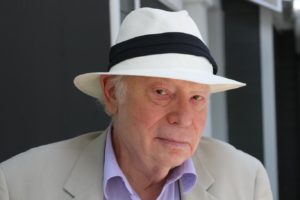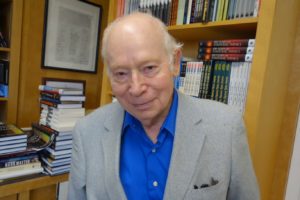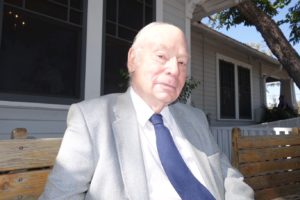Remembering Steven Weinberg

‘The greatest living theoretical physicist’ – many commentators in the past few decades have described Steven Weinberg in such terms. When I rather cheekily asked him what he thought of that statement, he shot back: ‘It is quite ridiculous to rank scientists like that’, adding with a twinkle in his eye, ‘but it would be impolite to dispute the conclusion’. That reply was classic Weinberg: self-aware, intimidatingly direct but always ready to lighten the moment with humour.
After Weinberg died on 23 July 2021, at the age of 88, there was a great sense of loss among physicists. For more than half a century, he had been an outstandingly productive researcher and one of his subject’s most forceful and eloquent ambassadors. He loved physics with a passion and made no apology for regarding the physicist’s way of looking at the world as uniquely valuable.
It had been clear from his days at school in the Bronx that he was bright, diligent and destined to be a formidable physical scientist. He excelled at university as a physics student, but – as he often told me – he did not take quickly to research because of his mistaken view that a scientist has to know everything about a topic before making creative contributions to it. It was this attitude, he said, that prevented him from making the most of his stay in 1954-55 at the Institute of Theoretical Physics in Copenhagen, where he met quantum pioneer Niels Bohr (‘he was very kind, but I never got to know him’, Weinberg later told me). Fifteen years later, he was at the front rank of theorists, determined to make his name in ‘fundamental physics’, as he called it – the study of the most basic forces and the most basic entities of nature. If he regarded a branch of physics as uninteresting or even of secondary importance he made no secret of his views, to the irritation of some of his colleagues, notably the brilliant solid-state physicist Phil Anderson.
Weinberg was one of the principal architects of the Standard Model, the physics of sub-atomic particles, arguably the greatest achievement of twentieth-century physics. Based on quantum mechanics and Einstein’s special theory of relativity, the model (now better described as a theory) gives a wonderfully complete and well-tested account of sub-atomic particles and all the forces acting on them, apart from gravity. His seminal, three-page paper A Model of Leptons, published in 1967, is one of the most-cited papers in the history of physics, a veritable classic. A few years later, he believed he missed an opportunity to make another key contribution to the development of the Model. He wished he had tried harder to prove that so-called gauge theories, on which the Model is based, can be used to make predictions to arbitrarily high accuracy (in technical terms, to prove that such theories are ‘renormalizable’). He believed that this problem was at that time too difficult to solve and instead expended much of his energy writing a textbook on Einstein’s theory of gravity. Meanwhile, the Dutch theorists Gerard ‘t Hooft and Martinus Veltman proved, in a virtuoso calculation, that gauge theories are indeed renormalizable. Crucially, this reassured physicists that they could make reliable predictions about nature using the Weinberg-Salam theory of weak and electromagnetic interactions.
One of the great experiences of my life was to witness, from the back row of the balcony, Weinberg and other leading theorists working with experimentalists in the 1970s to finalise and establish the Standard Model. For me, Weinberg always stood out as the most accomplished of the theorists, and I was certainly not alone. As an awe-struck graduate student, I often heard distinguished speakers make a big deal of Weinberg’s every comment or thought, even ones overheard in a restaurant. I can still hear physicist Chris Llewellyn Smith mentioning in one of his much-admired rapporteur talks: ‘Keep any eye on this – Weinberg is pushing it hard.’ Everyone wanted to know what Weinberg thought about everything to do with particle physics.
I first saw Weinberg in 1975 when he attended an international meeting of the Royal Society in London, to give a review talk at a day-long meeting. A colleague told me in advance that Weinberg always stood out at such meetings because he did not look like most other physicists, mainly because he dressed so formally. Sure enough, at the gathering, attended by some two hundred and fifty physicists, he was the only one wearing a three-piece suit. He cut a stocky, commanding figure and gave a predictably masterly and confident presentation, drawing on an evidently huge knowledge of both new theoretical ideas and the experimenters’ latest findings. Later, when I asked him if he was ever nervous before speaking to a large audience, he replied. ‘No. I don’t seem to have the gene for shyness.’
Every particle physicist knew that it was only a matter of time before leading theorists and experimenters responsible for establishing the Standard Model would receive a Nobel Prize. Weinberg received his in 1979, sharing it with Abdus Salam and Sheldon Lee Glashow (who had graduated in the same year at high school with Weinberg). Steven Weinberg did not have the easiest of relationships with Glashow but loved Salam, as I saw for myself in a seminar when Weinberg suddenly spotted him in the audience and exclaimed ‘Abdus!’, his face lighting up with the expression of a child who had just happened upon Father Christmas.
Weinberg had a characteristic style as a theorist. He wrote his research papers – dense, powerfully argued and oozing authority – in prose that seemed to cry out not to be printed on paper, but to be carved into granite. My only reservation about his presentations was that they sometimes summarised long chains of intricate reasoning with a concision that could baffle lesser minds. I remember once in the late 1970s that one of his short papers featured a delightfully compact equation, implying that its derivation was quite straightforward. After hours of thrashing about, in futile attempts to reproduce his equation, a colleague brought me the paper output of that the Macsyma computer-algebra programme demonstrating that the formula could indeed be straightforwardly derived, in about two hundred lines of working.
Weinberg had a remarkable feel for the workings of nature. Always beginning with experimentally well-established principles, he had an uncanny ability to set out regularities in the natural world and to use them to account for a wide range of measurements and observations. He loved mathematics, he told me, but it was only ever a tool for him: more than anything else, he wanted ‘to explain the world’, a phrase he used as the title of one of his popular books. In many ways, his approach was similar to that of Richard Feynman, and for many years I was puzzled by the many rumours I heard that they did not get on. Weinberg confirmed to me only relatively recently that the stories were true. ‘I didn’t like [Feynman] very much’, he admitted. The main reason was that whenever Weinberg gave a talk at Caltech, Feynman harried him mercilessly, to the point of cruelty. Several witnesses to these encounters told me that Feynman appeared to be jealous of Weinberg’s ascent to pre-eminence and could never resist trying to take him down a peg or two. Feynman’s brilliant colleague Murray Gell-Mann, also famous for his aggression, was a much more reasonable critic, Weinberg said: ‘If you set out a good argument, in a bullet-proof way, Murray would leave you alone’.
So far as I could see, Weinberg himself showed no such mean-spiritedness toward his talented younger colleagues, whom he was usually quick to praise. I was often struck by the sheer depth of his admiration for other top-drawer theorists, especially his late colleagues Joe Polchinski and Sidney Coleman, and the mathematical physicist Edward Witten.

In the mid-1970s, when Weinberg was still at his creative peak as a theorist, he began to demonstrate that he had another outstanding talent: writing about physics for a general audience. He was, perhaps unconsciously, following in the footsteps of his friend and admirer Freeman Dyson, a writer of rare grace and distinction. Like Dyson, Weinberg became a prolific contributor to the New York Review of Books and other magazines, and wrote several influential books for non-specialist readers. His most popular book was the cleverly titled The First Three Minutes, a short introduction to modern thinking about the beginning of the universe. First published in 1977, this slim volume outlined how theories hammered out by scientists in the past few centuries – sometimes in the past few years – can be extrapolated back billions of years to give a vivid picture of the Big Bang. The book was more than just a best-seller – it played an important role in highlighting to particle physicists and cosmologists how much they could learn from each other. Weinberg was one of the intellectual leaders of ‘astroparticle physics’, which foreshadowed an increasing closeness between disciplines that were previously largely separate.
Weinberg’s next popular book, Dreams of a Final Theory, was a collection of essays that he intended to bolster the case for building a Supercollider, an ultra-high energy sub-atomic particle collider, in the Texan desert. Lawmakers eventually cancelled the project, a decision that he regarded as the bitterest disappointment of his career. The book did not sell in the same vast numbers as The First Three Minutes, but it nonetheless endured as a must-read for anyone interested in fundamental physics.
It was at the London launch of Dreams of a Final Theory in 1993 that I was first introduced to Weinberg, initially at the publishers’ party and then over dinner at a restaurant. I sat opposite him and his wife, legal scholar Louise Weinberg, and spent the first half-hour too tongue-tied to open my mouth. But he was surprisingly friendly, chattier and much more fun than I expected. I could not resist asking him whether he kept a portable television on his office desk so that he could watch bad cop programmes as an occasional distraction from his work, as I had read. To my astonishment, the story was correct. Later in the evening, I learned that although he was obsessed by physics, he took a good deal of pleasure from the arts. One highlight of his stays in London, he told me, was to go to the theatre in the evening. I was amazed at the number and range of productions – including obscure ones – that he had seen. Nothing prepared me, however, for the surreal sight of Weinberg and his wife Louise, a distinguished law scholar, giving us a spirited rendering of one of their favourite Gilbert and Sullivan choruses. Later, in a quiet moment, he asked me about my favourite modern novels and volunteered that he had wept while reading Kazuo Ishiguro’s The Remains of the Day.
A few years later, he agreed to write a piece for the essay collection I was editing – It Must Be Beautiful– about some of the great equations of modern science. To my surprise, the book sold well in the U.S., and National Public Radio invited Weinberg and I to talk one morning about the subject, live on-air. The discussion went smoothly, though I was horrified that the presenter, nervously steering the discussion, appeared to be taking me as seriously as he did Weinberg, who later laughed off the absurdity of it.
After our first (and last) joint media appearance, we stayed in touch, and he usually sent me a signed copy of each of his popular books, which he produced with humbling frequency. Our correspondence was always friendly, though once he good-humouredly told me off for giving a philosopher of physics too easy a ride in a review of her book. ‘Nonsense should be called out for what it is’, he wrote. He could be brutal when he was attacking philosophers and historians when, in his view, they were naïve, perverse or ignorant about the subject he most loved. To some of his critics, Weinberg was a cold-hearted scientific, anti-religious rationalist, like a modern-day Pierre-Simon Laplace, but such an assessment is wide of the mark, in my view. When,in an idle moment, I asked him to name the person who had made the greatest contribution to humanity, he unhesitatingly plumped for William Shakespeare, and immediately recited a passage from ‘Hamlet’.
In the past decade, I visited him twice at the University of Texas at Austin where he held the Josey Regental Chair in Science, after he left Harvard. It was in those good-humoured, lively morning conversations in his office that I started to get to know him. I was there primarily to seek his views about the relationship between pure mathematics and theoretical physics, the subject of the book I was writing, The Universe Speaks in Numbers. He was a terrific interviewee – authoritative, fluent and clear, rarely more than a sentence or two away from an amusing observation, a witticism or even a joke. I was distressed to learn, however, of his deep disappointment that the Large Hadron Collider at CERN had generated so few observations which could give theorists a clear steer about the best way forward. This kept him awake at night, he told me, as he was beginning to fear the viability of particle physics, which needs substantial government money to fund its experiments. In return, governments want spectacular discoveries as evidence of money well spent.
Twenty years earlier, Weinberg had believed that a ‘final theory’ of physics was nigh; in 2021, such a theory seemed as far away as ever. He remained a ‘fan of string theory,’ and was contemptuous of many of its increasingly vociferous critics, most of whom did not know what they were talking about, in his view. But Weinberg was glum about the prospects of testing it in meaningful ways in the next few decades. He told me that he could only be happy as a theorist if experimenters were giving him regular feedback from nature about his speculations.
Although he jokingly referred to himself as ‘an old fart’, he refused to criticise the many young theorists who approached physics in ways that he believed were too mathematical for his taste. He found it sad, he told me, that some theorists could forge an excellent career without once having the experience of seeing one of their predictions checked experimentally. Weinberg believed, nonetheless, that today’s theorists are of the same quality as their predecessors, and are doing the best they can, in difficult circumstances. The most important thing is, he said, is to ‘keep buggering on’, borrowing Winston Churchill’s famous comment about his leadership style during World War II
The last time I talked with Weinberg was at a convivial summer lunch with him and his wife at an old-fashioned hotel in The Berkshires. The couple – always a pleasure to be with – were on excellent form, laughing loudly at the prospect of President Trump, and proudly showing me photos of their daughter Elizabeth and her family. While Louise was briefly away from the table, Weinberg told me about some of his favourite recent physics papers, which he had recently read on the arXiv website. He still checked into it at the beginning of every day.
After Louise returned to our table, and during a brief pause in the conversation, I took the opportunity to ask Weinberg the question I had long wanted to ask him: would he be happy if I wrote his biography? He hemmed and hawed, before muttering something about his hopes of starting a memoir after he had written his next textbook. I knew for sure my planned Weinberg biography was doomed when Louise lent over the table and said to me with a smile: ‘Don’t do it! Steve Weinberg is the most boring man in the world – all he does is work!’
Louise was, of course, being hyperbolic and was warning me off. I knew immediately that it would be futile to resist, and her words reminded me that, although her husband could be described in many ways, being boring was not one of them. Yes, he was above all a truly great physicist. But he was much more – a polymath, a public intellectual, a sparkling conversationalist, a family man and a loyal friend. I hope that the life of this remarkable human being will be written by a biographer who is worthy of the challenge and able to do full justice to the immensity of his achievement.
Graham Farmelo
An interview of Steven Weinberg by Graham is available in the podcast series, The Universe Speaks in Numbers
